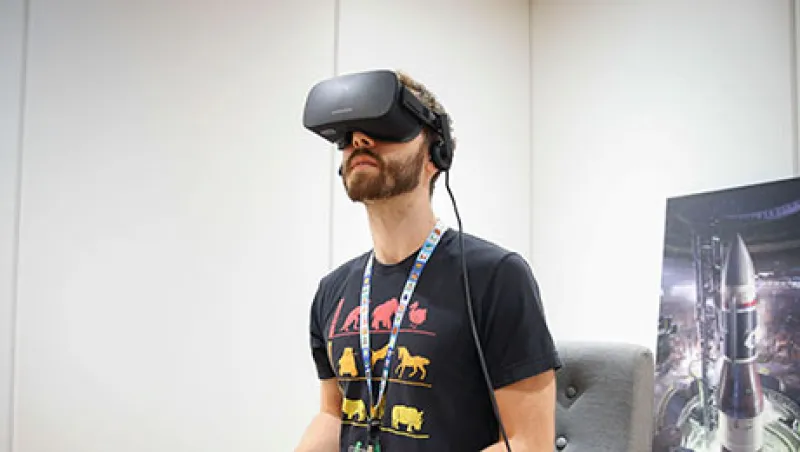The first immersive artistic experience we know of is the Chauvet-Pont-d’Arc Cave in France, painted 32,000 years ago. For legendary German filmmaker Werner Herzog, Chauvet provided a fascinating subject for his 2010 3-D documentary Cave of Forgotten Dreams, the first film of its kind to receive a widespread theatrical release. Herzog allowed images — of hunts, ceremonies and other aspects of ancient human life — to lift off the walls, inviting audiences almost to touch them. Forget the screen, the film wanted to say; forget everything except what you’re seeing.
Now imagine that you can take the cave and strap it over your eyes. The idea is a little silly, but it’s close to an accurate analogy of virtual reality technology. The next generation of VR headsets utterly immerses the user in the entertainment — movie, story or game — in front of them, literally putting the user in the cave.
How close are we to realizing that dream? Virtual reality is far from perfect. For one thing, our brains can’t quite handle it. Certain camera angles make the user motion sick (or “simulator sick,” as the professionals have it). For another, the basic technology can’t quite do what we want. You can strap a screen to someone’s face and use low-latency sensors and magnets to track the motion of their head and eyes so that the screen reacts to their movements in real time — no sweat — but using a controller at the same time becomes very difficult because the headset blocks users from seeing what they’re doing with their hands. On the production side, VR movies are extremely hard to shoot because directors can’t see what they’re filming with any accuracy, at least not in real time. The list of obstacles to creating VR entertainment, as well as purchasing it for any affordable sum, could go on and on.
Nonetheless — and perhaps because the race is still very much on to get what could be a marvelous technology right — investors interested in learning about and profiting from advances in VR have a number of options, bellwethers and leaders to track. The first is Oculus VR, whose Rift headset may be said to have initiated the most recent wave of VR consoles. Designed by a VR enthusiast named Palmer Luckey, the Rift launched in 2013, following a Kickstarter campaign that raised $2.4 million for a company less than a year old. The design was good, an immense improvement on everything that had come before — including models that first retailed at $100,000 a pop. Alas for some, last June, Facebook bought Oculus for $2 billion, presumably under the assumption that VR would become the next big computing platform.
Investors who aren’t interested in Facebook, however, might look to Oculus’s primary partner, Samsung Electronics, with which it developed the Gear VR headset. Gear VR accepts Samsung Galaxy Note phones, making the headset itself almost an accessory to the smartphone (which may mean VR won’t become the next big computing platform after all). As a whole, the product implies accessibility and general affordability.
Microsoft too is friendly with Oculus. Its Xbox gaming division designed and manufactures the controllers that are included with the Rift. Microsoft’s own mixed-reality effort, the HoloLens, was built in conjunction with a gaming company, Bellevue, Washington–based Valve; in its turn Valve partnered with Taiwan-based HTC for the HTC Re Vive headset. Other big firms have rolled out their own models, including venerable European optics company Carl Zeiss, with its Zeiss VR One.
As is the case with the Rift, Gear VR and Zeiss VR One — as well as Fove, which offers eye tracking — most VR headsets can be used for both gaming and cinema. Users experience virtual reality as though they were exploring a world in the first person; this is very common in gaming but almost nonexistent in narrative film. Thus there are already a number of players in the VR gaming field: Sony Computer Entertainment opened the first studio dedicated entirely to VR gaming with its Project Morpheus; they’re in the thick of designing content for a head-mounted VR console scheduled to roll out in 2016 and meant to impress hard-core gamers and tech heads.
Other attempts are friendlier, open to users who want to explore virtual reality affordably. In June 2014, Google debuted its smartphone-compatible VR viewer, Cardboard — which is, in fact, made of cardboard. Several different manufacturers have created Google Cardboard arrays; the plans are also available online so that users can make their own viewer. Those companies that may develop out of or be supported by an ever-growing fleet of Cardboard apps — games, experiences, publishing platforms — will bear watching. Already some of the problems that have prevented a true flood of VR production for cinema are being solved. Palo Alto, California–based Jaunt, for example, has rolled out its first VR camera. About 15 miles north of Jaunt, in San Mateo, camera company GoPro has revealed a 360-degree camera for making fully immersive VR experiences at home; the project was undertaken in partnership with Google and its newest undertaking, Jump — a video production environment, not yet released — and is intended for use with Cardboard.
But the full history of virtual reality — from James Cameron’s Avatar, which could be said to have saved 3-D cinema from the ’70s kitsch bin before Cave of Forgotten Dreams, to Lost, the first short film for the Rift, which premiered at the Sundance Film Festival this year — is still to be written. Or, more appropriately, it is still to be experienced, in all its dimensions. Other applications in the near future include live chat, enabling users to convincingly simulate physical presence in real time, triggering all the same emotions and reactions. That’s a terrifically exciting idea — as exciting as visiting the Chauvet caves or Jurassic World or any other of the dynamic environments that already appear in IMAX 3-D cinemas. We’re not staring down into a cave; we’re peeking over the horizon, at new forms of human life and art.






